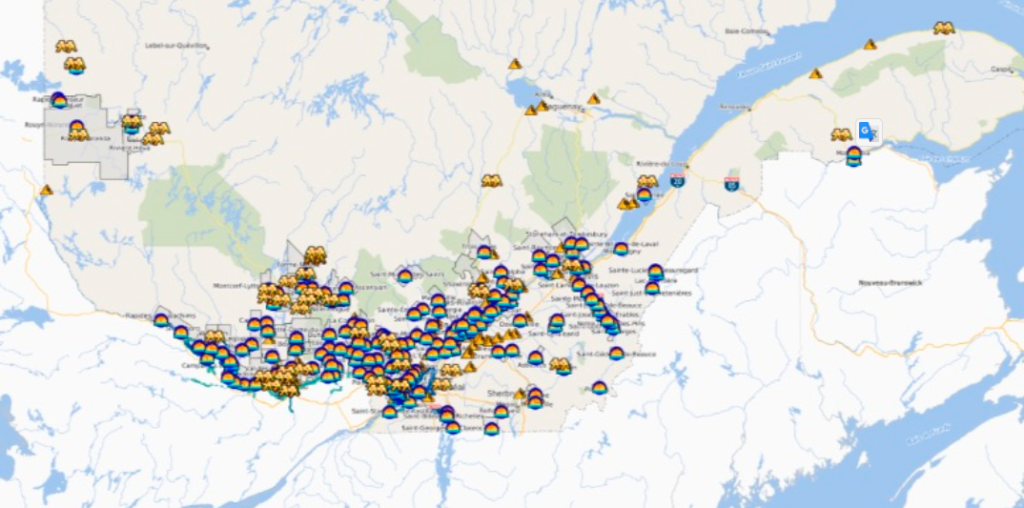
According to data published in 2019 by public Security, roughly 5447 houses have been flooded and 10 386 people have been forced to evacuate their homes, notably, in the Outaouais and Laurentian regions.
While there was major floodings recorded between 2011 and 2017, the situation in 2019 was exacerbated by the rupture of the Sainte-Marthe-sur-le-lac dam. The rupture in question facilitated the flooding of land neighboring the Two Mountains Lake, rendering over 5,000 people unable to return to their homes for several weeks. Having lost most of their possessions, those affected faced great uncertainty as to their future. It must be emphasized that most of the sites affected by the floods were sectors flagged as flood zones, which had a chance in 100, or a chance in 20, to be flooded again.
The record flooding of 2019 forces ourselves to ask whether we are to expect worst conditions this year. Given that this winter saw less snowfall than last years and predictions of a cooler summer, there is potential for less flooding in Quebec area’s this spring. However, given the recent spreading of the coronavirus, any major cases of flooding and the measures that will be taken to deal with them, will be exacerbated by governments trying to control the spreading of the virus. Thus, any attempt to control or mitigate the impact of these floods, will have to take include safety measures to prevent the spread of Covid-19. The city of Gatineau, for example, was forced to adapt its response plan for this summers floods to reflect the safety measures put in place to combat the coronavirus. The City published an announcement that mentioned that even in a flood situation, the physical distance measures prescribed by the provincial government will have to be respected [1]. The message went on to say that the City would do its utmost to support its residents, but the level of service it will be able to provide will be more limited than in the past [2]. Thus, the global pandemic will make it more difficult for local governments to deal with this years flood season.
Moreover, attempting to control great amounts of water with dams, creating artificial flood free zones, and replacing wetlands through artificial means, in our era of great climate change and global pandemic, is becoming more and more careless. While humans are drawn to inhabit nature’s empty spaces, the risk of doing so is becoming more dangerous.
While responsible urban planning sheds some light on the importance of sustainable legislative measures, the present situation flushes out a much bigger problem: a collective unawareness of environmental issues and a lack of awareness of the biol-cultural relationships we share with Nature. The complacency of public authorities, government, and municipalities to allow urban development close to the riverbanks is a clear indication of said ignorance. Every spring, the expanse of the River’s surface water causes the river to overflow its banks. This is a natural and predictable characteristic of the river. Thus, it was inevitable that ignoring this reality would lead to the disaster Quebecers are currently facing.
Therefore, there is no solution other than to give back the water’s natural pathways to the Saint Laurence River. In this sense, prevention must be synonymous to the respect of the River’s natural cycles. Respect is to recognize the River as a subject of law. Recognizing it as such, acknowledges the River as a dynamic, living being which is home to millions of species. Making the River a subject of law will codify the respect of its natural course, its cycles and the species that inhabit its environment.
Furthermore, recognising the River as a subject of law allows us to protect the bio-cultural links that local and indigenous populations have with it. In fact, making it a subject of law allows those bio-cultural links to flourish through the recognition of its intrinsic values and relationships it has with the people sharing spaces with the River. Thus, to give the River and its tributaries a legal status is to recognize its right to life, restoration and protection (principles of prevention and precaution included).
Like the Whanganui River in New Zealand and the Atrato River in Colombia, to grant the Saint Lawrence River a legal status is to impose on our society and citizens an obligation of respect towards its rightful place in Nature. This upholds the River’s rights beforehand, instead of acting downstream with sanctions and looking for culprits.
This is a real change in the environmental paradigm which will avoid huge damage in the years to come and benefit our future generations.
It is time to give what belongs to the River back to the River!
For this reason, we want the government to recognise the Saint Lawrence River as a subject of law. We are presently circulating a petition with more than 800 signatures which aims to amplify the populations’ voice of concern for the River to our governments. If you wish to share your voice with this movement, please sign the link that follows: https://www.thepetitionsite.com/fr-ca/716/873/803/déclaration-du-fleuve-saint-laurent-comme-sujet-de-droit/
[1] https://www.ledroit.com/actualites/gatineau/gatineau-se-prepare-a-de-possibles-inondations-avec-la-covid-19-en-tete-13411644058215b440554795a3ce09d9?fbclid=IwAR3hMSSb5FdWLdgQN3R8aWuwz1hhp6RdzR3AaHzfUmBepfik3AF_c74elOU [2] Ibid.
